Jason Gan has been involved in the Lang Tengah Turtle Watch since he was an intern there in 2019. As site manager now, he juggles several responsibilities and has learned through the hard way that conservation is no walk in the park.
To continue reading, subscribe to Eco‑Business.
There's something for everyone. We offer a range of subscription plans.
- Access our stories and receive our Insights Weekly newsletter with the free EB Member plan.
- Unlock unlimited access to our content and archive with EB Circle.
- Publish your content with EB Premium.
Firstly, turtle egg poaching is so common along the Malaysian East Coast, where the conservation organisation is located at, that the turtles hardly have a chance at survival. For a green sea turtle, a species that the turtle watch primarily works with, only one in a thousand survive to maturity, and the chances are slimmer now due to human activities, such as overfishing, bycatch, marine pollution and poaching. The true survival rate may be one in 5000, or worse, shared Gan.
Conservationists and researchers hence fight an uphill battle trying to monitor turtle landings and rescue the eggs. “Sometimes I do question how much individual efforts can help with the long-term survival of the species and I then feel unmotivated because the odds are so slim,” said Gan. “But I have come to realise that we have to do whatever we can, because every bit counts.”
“If we do not do it, who else is going to ensure that this species see more generations? Who else is going to ensure that they don’t go extinct within our lifetimes?” he added.
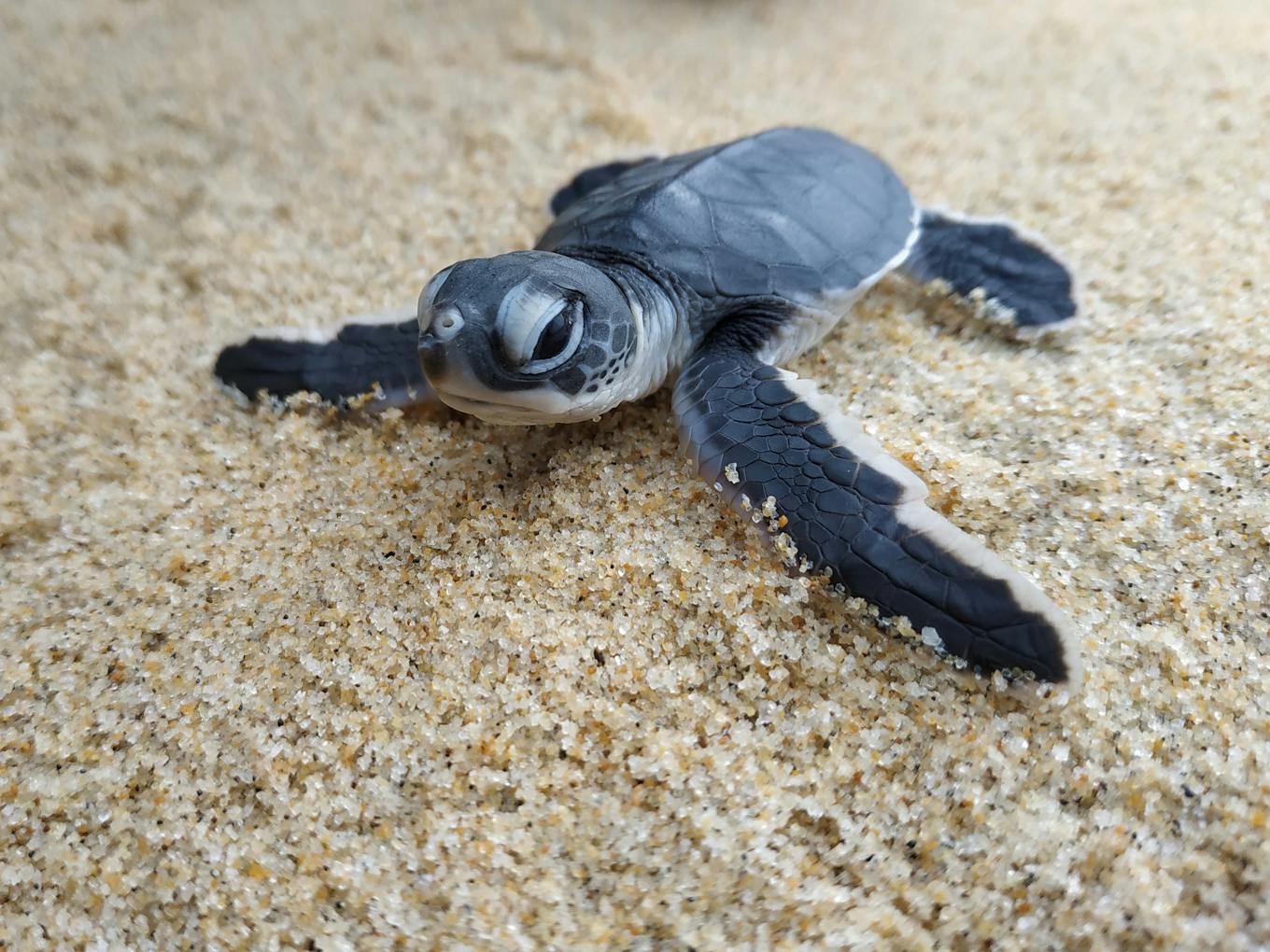
A bright-eyed green sea turtle hatchling making its way to sea. Image: Sharifah Shafiqah/ Lang Tengah Turtle Watch
With consistent efforts, the turtle watch project, carried out on the beaches of Lang Tengah, off Terengganu in Malaysia, has showed some results. Gan and his teammates also work hard at advocating against legislation that harms the endangered species.
In 2021, Lang Tengah Turtle Watch managed to save over 21,000 sea turtle eggs. By 1 June 2022, Terengganu will also enact a full ban of the sale of turtle eggs. It will be the last state in Malaysia to ban the sale of all types of sea turtle and freshwater turtle eggs.
Sharing about his work, Gan said that what is most exciting for him usually happens in the wee hours of the morning, when he gets to witness a mother sea turtle laying her eggs on the beach.
March to late October is the season for sea turtles, where mothers will come up to the beach to lay their eggs, which take 50 to 60 days to incubate. At one go, green sea turtles lay about 100 eggs (+/- 50 eggs) per clutch to increase their chances of survival against predators.
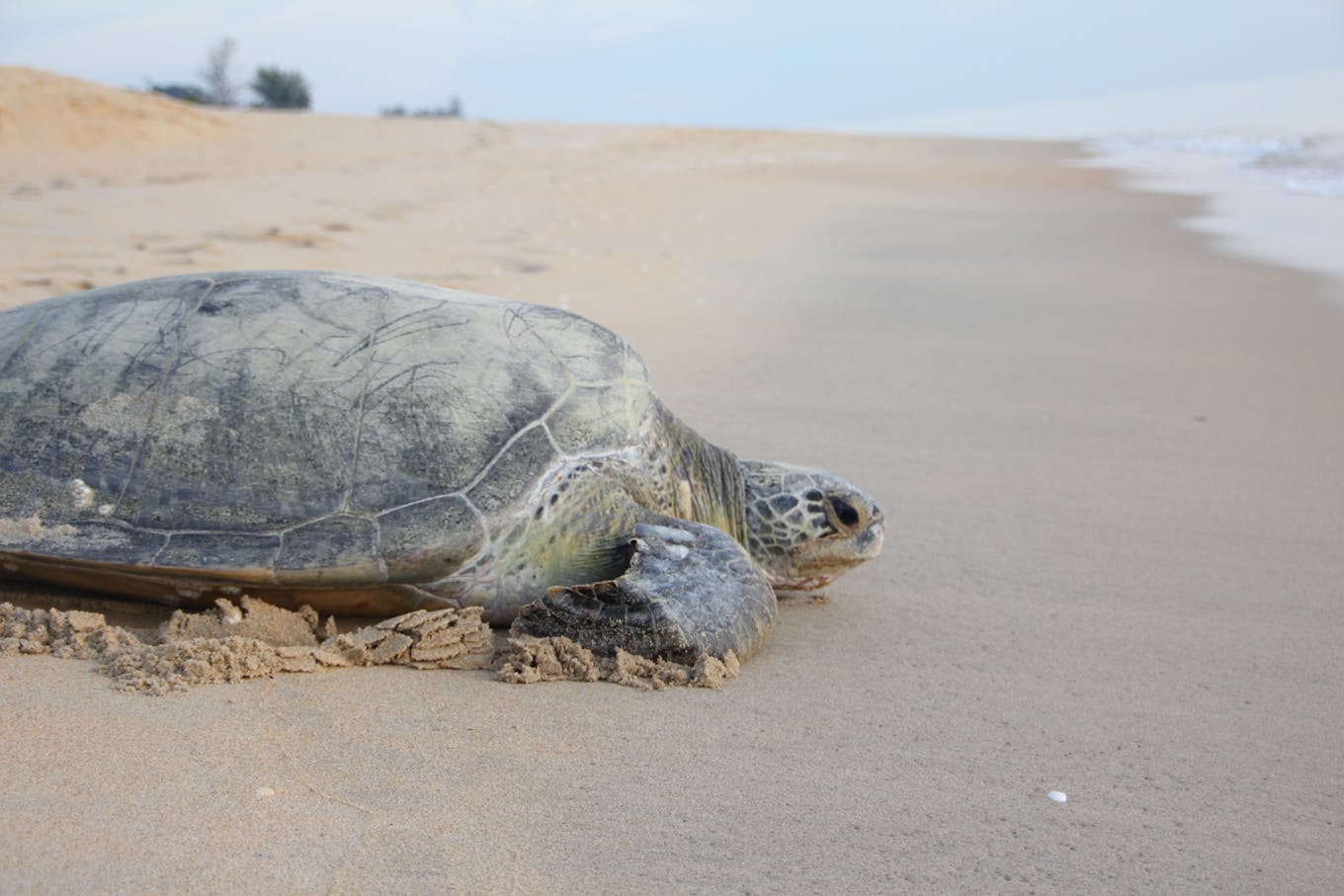
A green sea turtle mother returning to sea after laying a clutch of eggs. Note the unique pattern of facial scales on her face. Image: Ella Loeffler/ Lang Tengah Turtle Watch.
Here is how a particularly busy working day (and night) goes for Gan:
8am: I generally get up around this time unless I have a late night. I grab soy milk and a few slices of toasts for breakfast. If I have enough time, I like to have breakfast at the patio of our project house, which has a magnificent view of the Terengganu beach and the South China Sea.
9am: I start working on my laptop in my office, which is right outside the room I sleep in. I liaise with our funders, donors, or whoever who wants to collaborate with us, via emails or zoom calls.
One misconception I had when I started out in conservation is that I would be spending all my time doing fieldwork with animals and be deep in the environment. But the reality of being a site manager is that many other aspects of the site require my urgent attention too.
9.45am: Before we start the day proper, I like to have a quick huddle with my team of research assistants and interns to make sure that everyone is on track with their tasks, such as data collection and entry, hatchery upkeep, or other project-related activities.
Before the pandemic, we had an extremely diverse team of people from all over the globe who would come to do an internship with us. Since the closure of the borders, we have only been able to hire Malaysian interns, which is equally fun, because then we get to meet interns from the different states in Malaysia.
10am: The day begins. We usually walk or cycle to the visitor’s hut, called wakaf in Malay, which is made in traditional Terengganu architectural style and is beautiful. Here is where we conduct the bulk of our outreach and educational work.
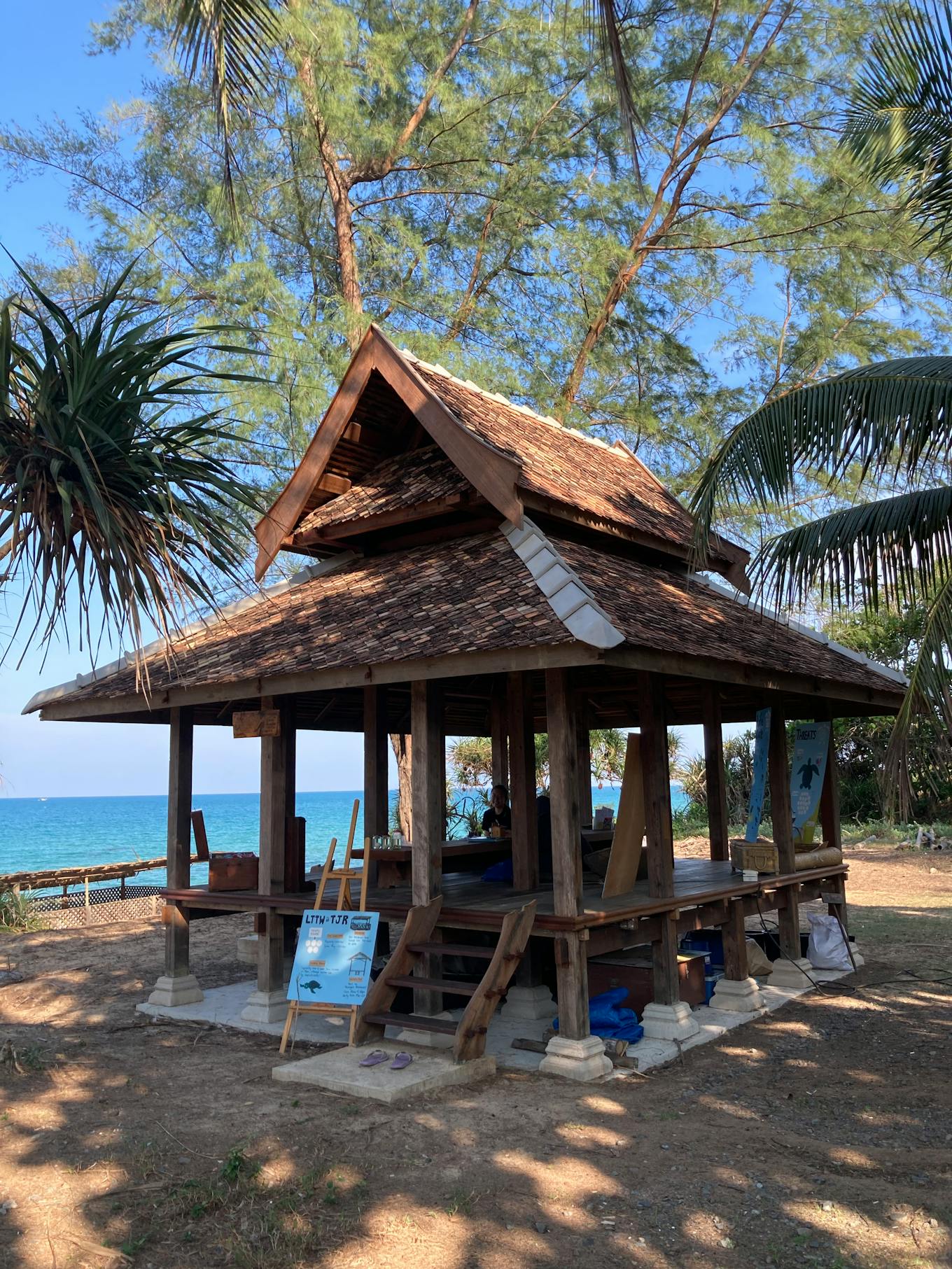
The visitors’ hut at Tanjong Jara Resort, built in the traditional Terengganu architectural style with no nails used. Image: Hayati Mokhtar/ Lang Tengah Turtle Watch
We have partnered Tanjong Jara Resort over the past few years and they have kindly provided us with this space to reach out to their guests and members of the public. Visitors from all over the world visit us, and here we talk about the work that we do to save endangered sea turtle populations on the East coast of Malaysia.
Our visitor hut overlooks the hatcheries where we safely incubate thousands of sea turtle eggs at one go. It is made out of recycled wood from around the area, and we hired local artisans and craftsmen to set it up. The shading is made out of palm leaves, we do not use any plastic to shade our hatcheries because research has shown that natural shading is the best when it comes to hatcheries.
1pm: Lunch time. Terengganu food is awesome, my favourite meal is nasi kerabu, which is a dish made out of fresh raw vegetables, charcoal roasted chicken accompanied by the star of the show, fragrant blue rice coloured by blue pea flowers.
The nearest town is about 15 minutes away though, so if we have no time to go out for a meal, we will whip up a quick one in the kitchen.
2pm: Time to give virtual tours. Due to the Covid-19 pandemic, we have been forced to innovate in the ways that we generate income and reach out to more people. So we came up with virtual tours which put viewers in our shoes and give them a first-hand look into our hatcheries. We have had great success with these tours and intend to continue doing them even though our border restrictions are easing.
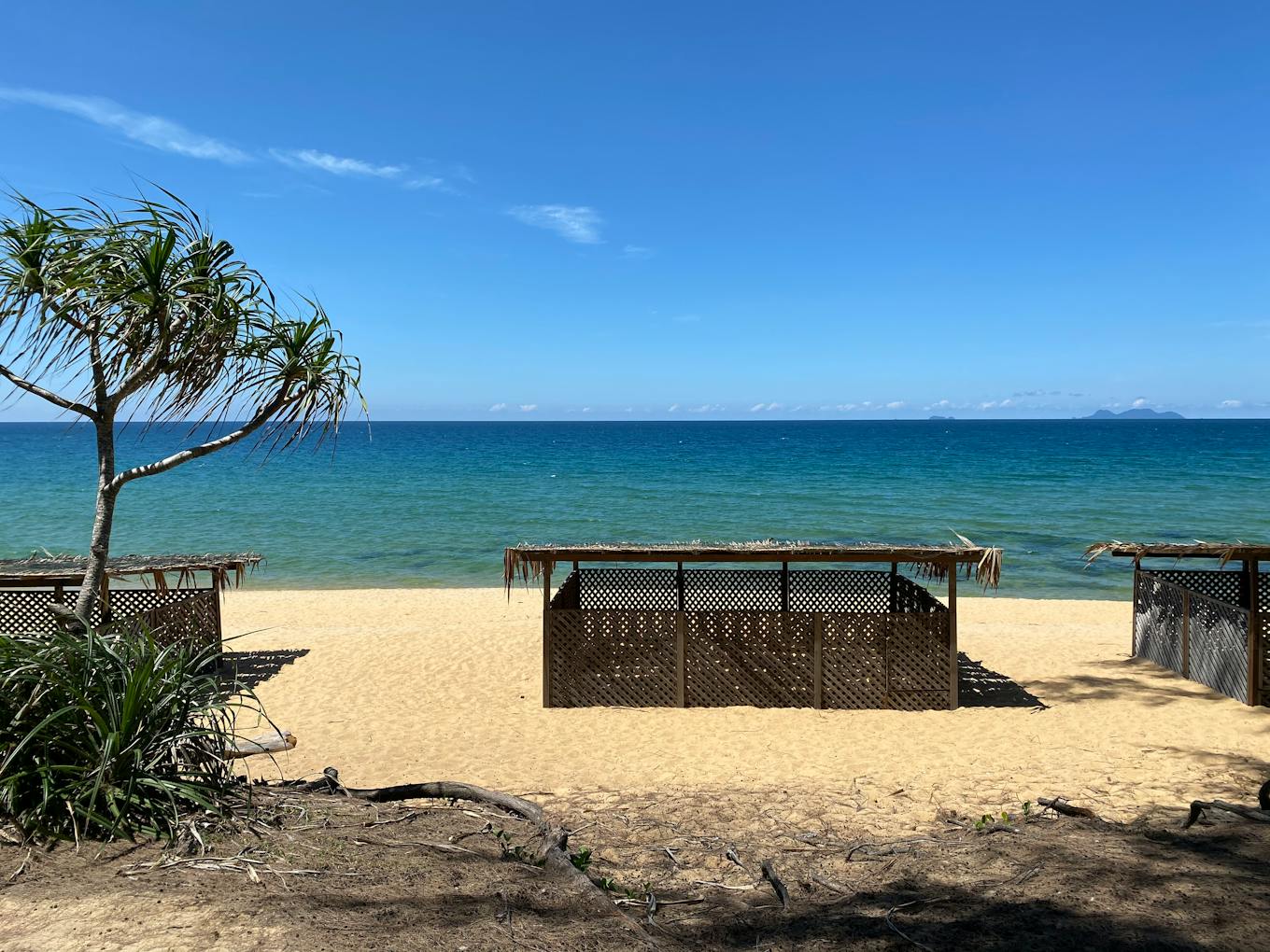
The view of the wooden hatcheries and the South China Sea on a sunny day. Image: Jason Gan/ Lang Tengah Turtle Watch.
5pm: This is my favourite time of the day because we do what we call post-emergence inspection (PEI), which means that we excavate or dig up a sea turtle nest and we assess its success rates. We only do this a few days after a mass emergence has occurred.
A mass emergence is when the majority of hatchlings break out of their shells in the nest and make their way to the surface. Once they are at the surface of the sand, they form a sort of ‘turtle boil’ where they are stepping over one another to come up. It is always a joy to be able to witness that.
Emerging together in a mass emergence means that they have an easier time making it out of the nest because the nest can be up to 70 centimetres deep, which is quite a distance for baby turtles to climb their way out. There is strength in numbers, and a mass emergence ensures a higher rate of survival against predators like birds.
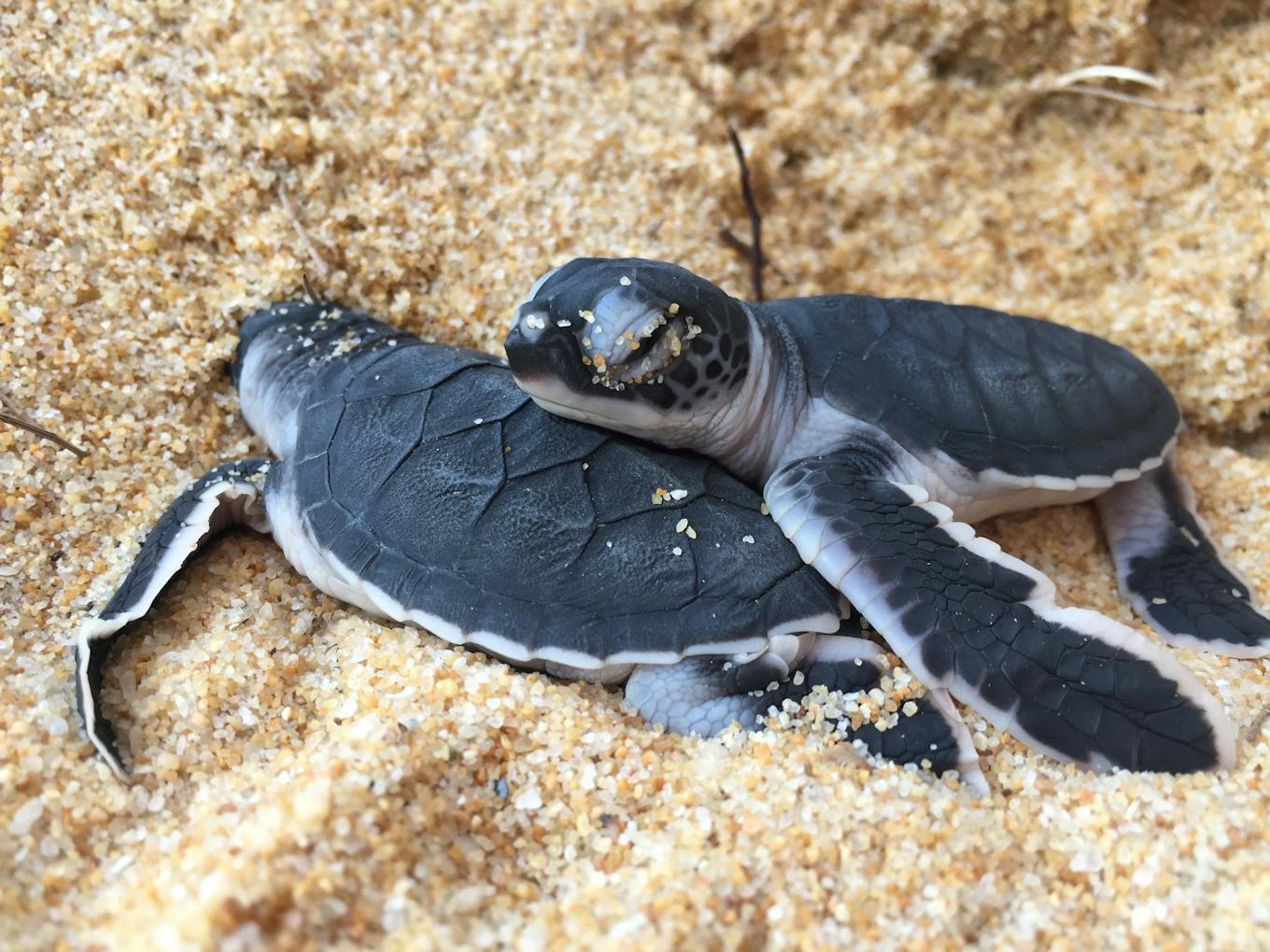
Two green sea turtle hatchling stragglers (those that did not make it out with the rest of their clutch in a mass emergence) sleepily laying on the sand in the hatchery. Image: Lang Tengah Turtle Watch.
So the PEI comes after the mass emergence, and allows us to figure out how many hatchlings have successfully hatched from the eggs, and if they did not, why not? It could be from crab predation or fungi predation, or sometimes the eggs simply did not develop because they were not fertilised. We log all the biological data down meticulously because we cannot go back to it after this.
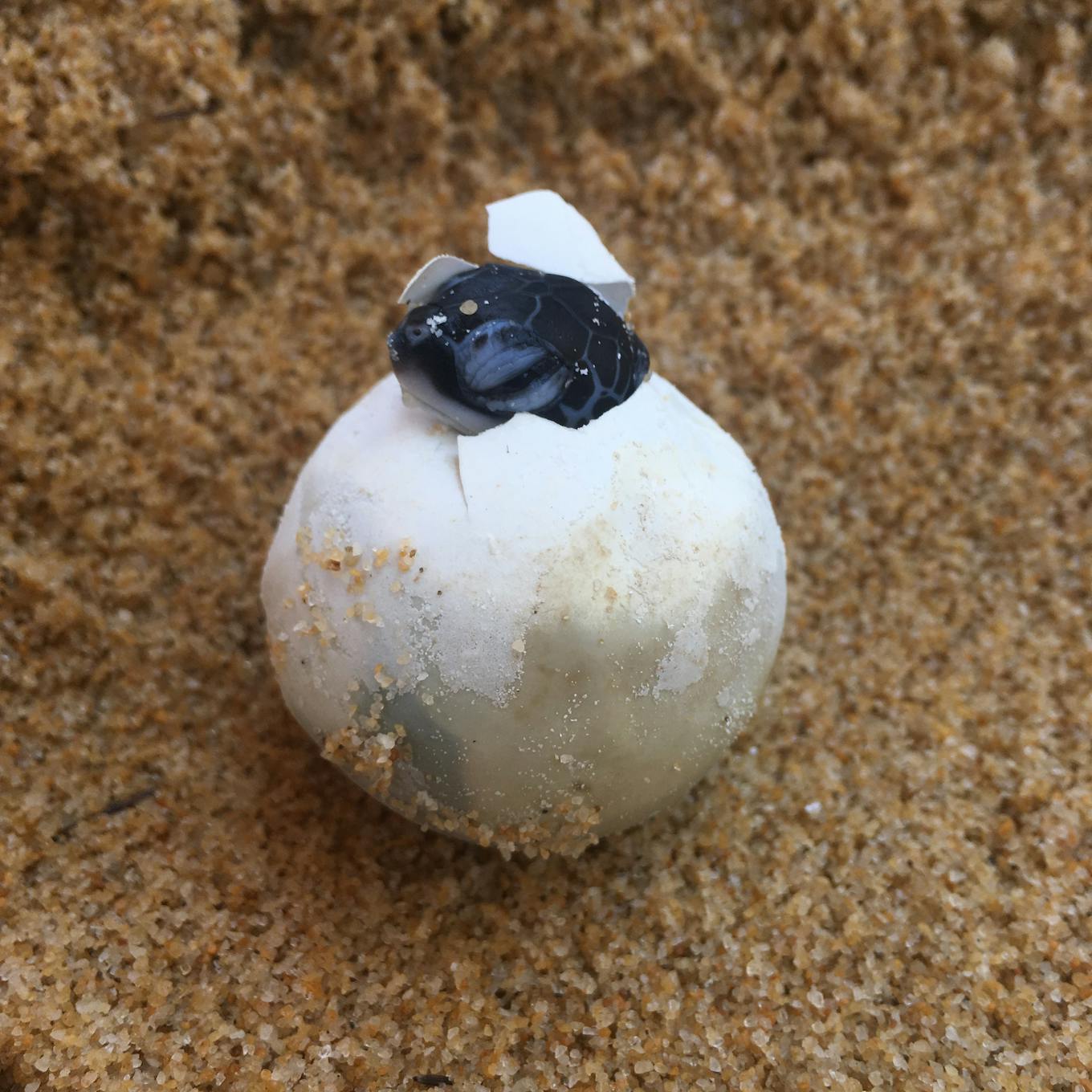
A green sea turtle hatching “pipping” (using a specialised body part called an egg tooth to break out of its shell). Image: Jason Gan/ Lang Tengah Turtle Watch
All the data helps us to improve our conservation efforts. We are also in the midst of writing and publishing papers about the findings in our hatcheries. PEIs are extremely fun as we get to see sea turtle eggs in all stages of development, from the leathery-like eggs to the impossibly cute baby turtles.
7pm: Dinner is a communal affair between the members of our conservation team. We usually cook together, sit down and share stories of our days. Living on the project site means that your colleagues are your friends, so it is a good idea to get along with everyone.
9pm: It is time to check on the hatcheries once again. During peak season, we will most likely find another mass emergence. We have specialised nets that keep the hatchlings around the nest, so they do not run everywhere and tire themselves out before reaching the ocean. I have to stress that it is imperative that we check on the hatcheries as often as we can throughout the night.
When the hatchlings emerge, they go into this sort of frenzy, where they expend a lot of energy because they want to reach the sea as soon as possible. In order to make sure they do not tire themselves out, we have to release them the moment they come up to surface.
The hatchlings tend to emerge at night or during the late evening because the cooler temperatures on the surface signals for them to emerge from the nest. Cooler temperatures means they get exhausted less quickly, and the darkness helps prevent them from being seen by predators.
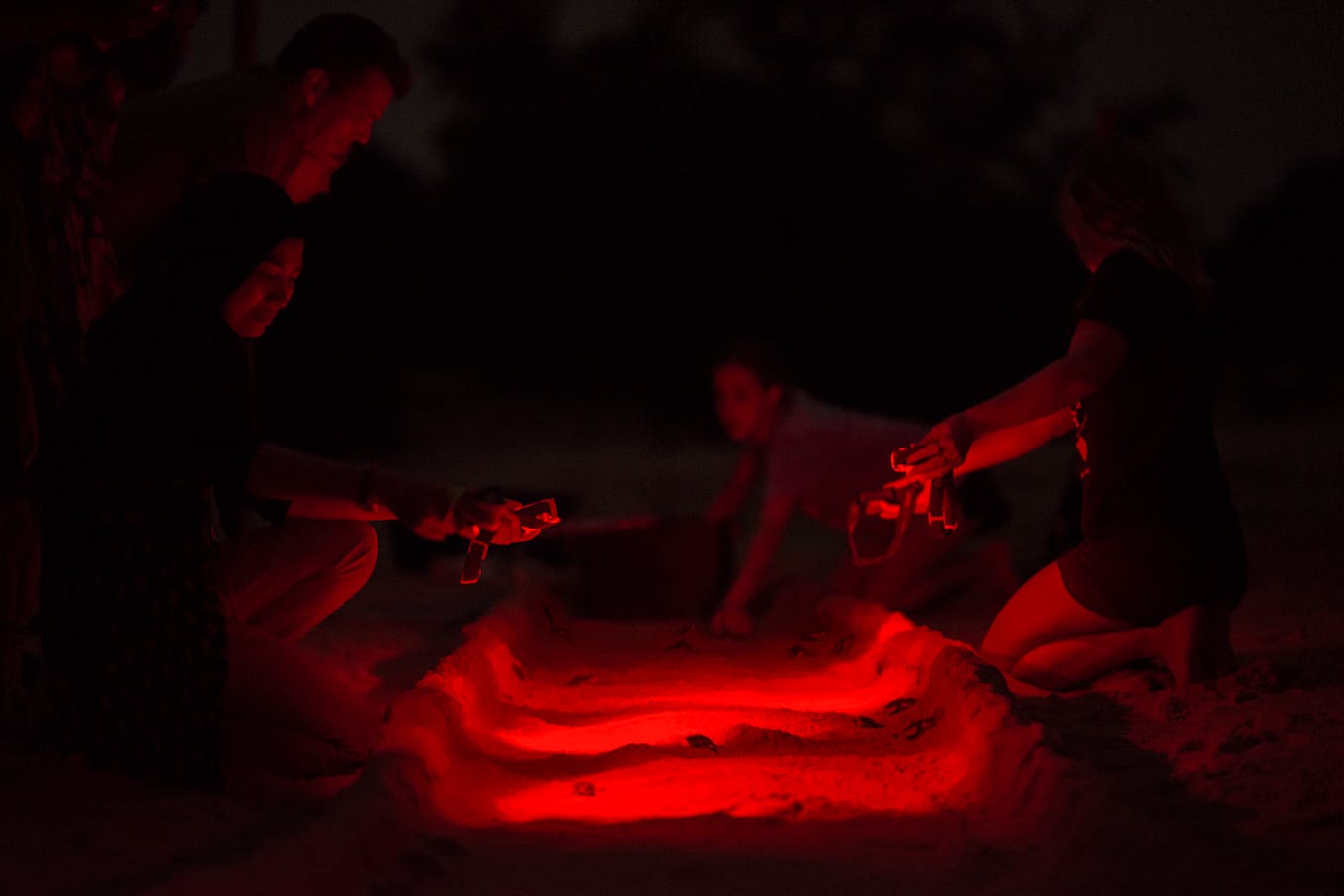
Lang Tengah Turtle Watch team members releasing hatchlings under red light so as to not disorient them, as guests look on. Image: Lang Tengah Turtle Watch.
It is important that we release them on the beach and give them a bit of running space—about six or more metres. This helps them to imprint on the beach where they are born on and hopefully gives the females the ability to come back 25 to 35 years later to lay their eggs on the very same beach.
11pm: Lights out.
3am: In the middle of the night, our project phone rings extremely loudly to ensure that the person on call does not miss it. If I am on duty and answer it, I will generally hear our local ranger say, “penyu, penyu!” which means turtle in Malay.
We manage about an 8-kilometre stretch of the beach, which can only be patrolled by foot so we do not scare off the sea turtles. So we work closely with local rangers who patrol every night.
At this point, we quickly gather all the materials we need, a measuring tape, a bucket to relocate the eggs, an egg counter, our datasheets, surgical gloves, etc., and head to the beach immediately.
Once we have found the mother sea turtle, we have to be really silent because we do not want to interrupt the process of laying eggs. We stay about 10 to 15 metres away and just observe what she is doing. When we see the sand flying around, we know that she is in the process of digging herself a body pit, a large area where she can just lower herself down to lay eggs.
Once we stop hearing the sounds of sand being thrown above, I slowly crawl up to the mum from behind her and turn on my headlamp, which is equipped with red light to be less disruptive to the sea turtle. The next step for her is to dig an egg chamber and then lay the eggs. She is usually hyper-focused on laying eggs at this point and that is when I can either put my hand underneath her cloaca to catch the eggs, or reach into the egg chamber to collect the eggs.

A green sea turtle mother camouflaging her nest from potential predators. Image: Jason Gan/ Lang Tengah Turtle Watch.
When she is done laying her eggs, she will cover her nest with her back flippers and she will pat the sand above to conceal her nesting spot. This is the best time to collect biometric data on her, to see if we can identify her in our database, or if she is a new mother.
We share our database with other sea turtle projects, so we can map out the routes of turtles or have a snapshot of where they are during mating or feeding season. Sometimes they travel all the way to the Philippines or Thailand!
The whole nesting process can take anywhere from one to four hours, which can be really tiring but rewarding. One of the most beautiful sights to me is the mother sea turtle returning to the water as the sun rises overhead. Hopefully we will see her again soon. Or maybe it was her last time laying eggs for the season, then we’ll see her in about two to four years.
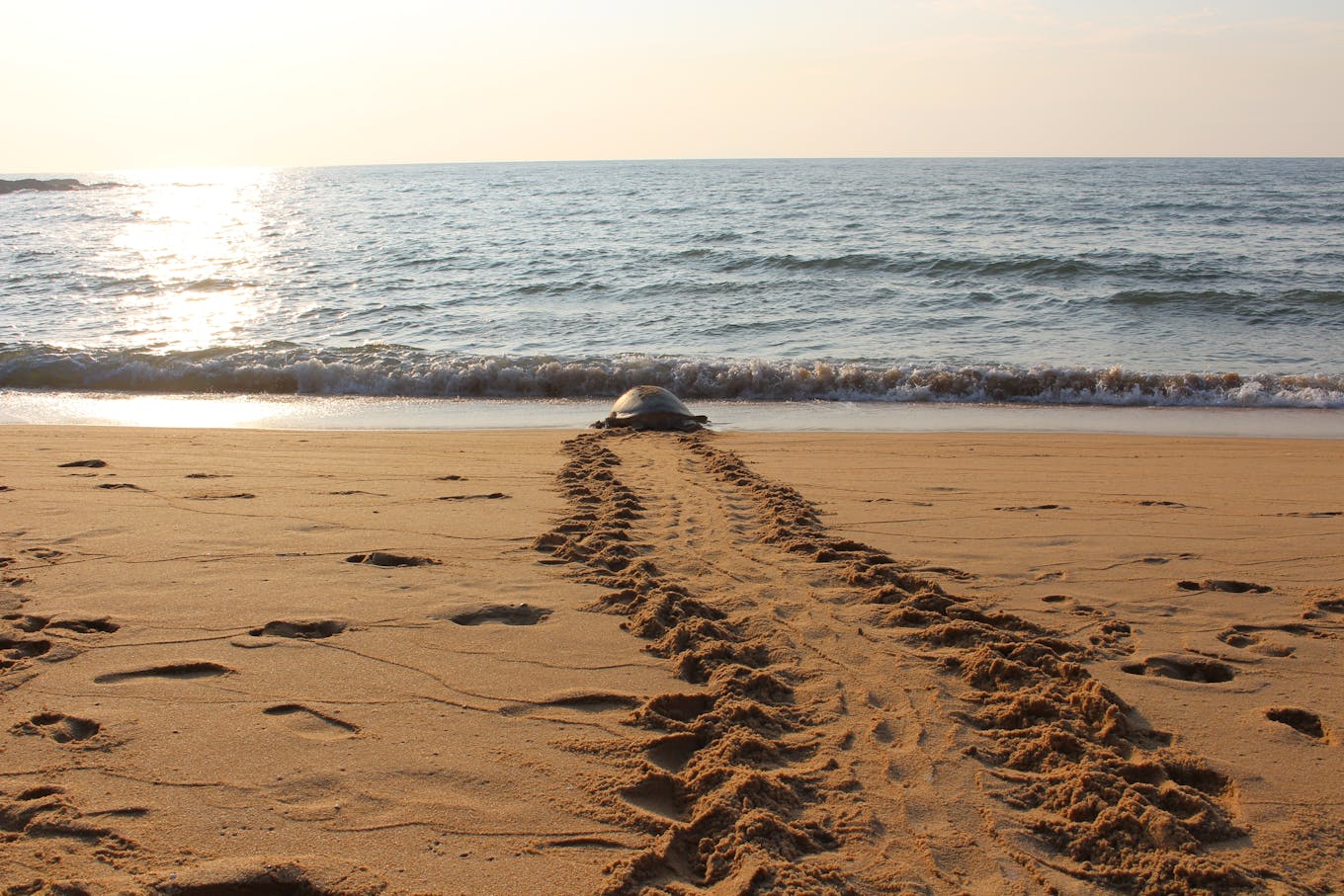
A green sea turtle mother returning to sea as the early morning sun washes over her. Image: Lang Tengah Turtle Watch.
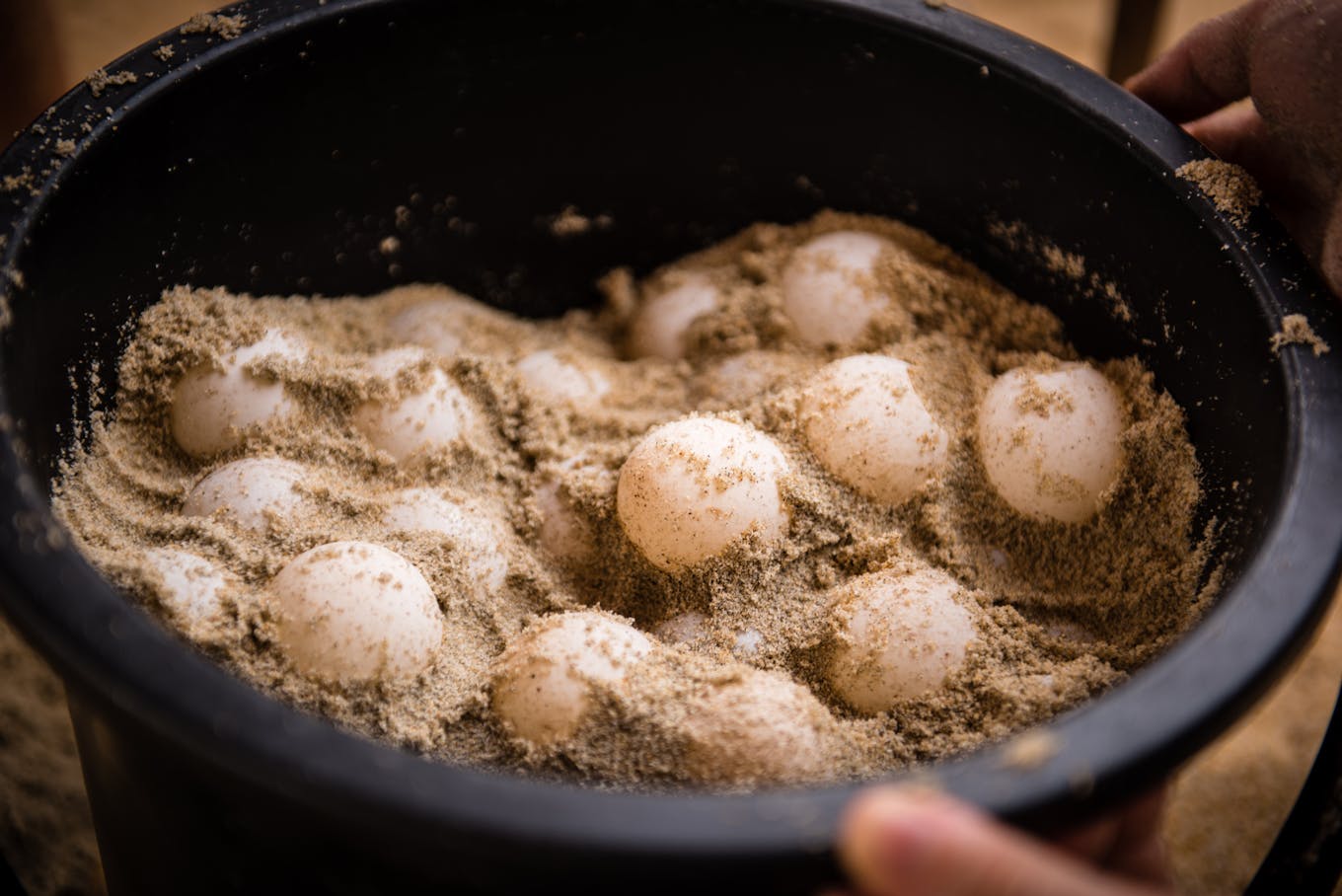
Freshly laid green sea turtle eggs ready to be transported to the safety of the hatcheries. Image: Lang Tengah Turtle Watch.
7-8am: End of day, try to sleep and prepare for the next day.












